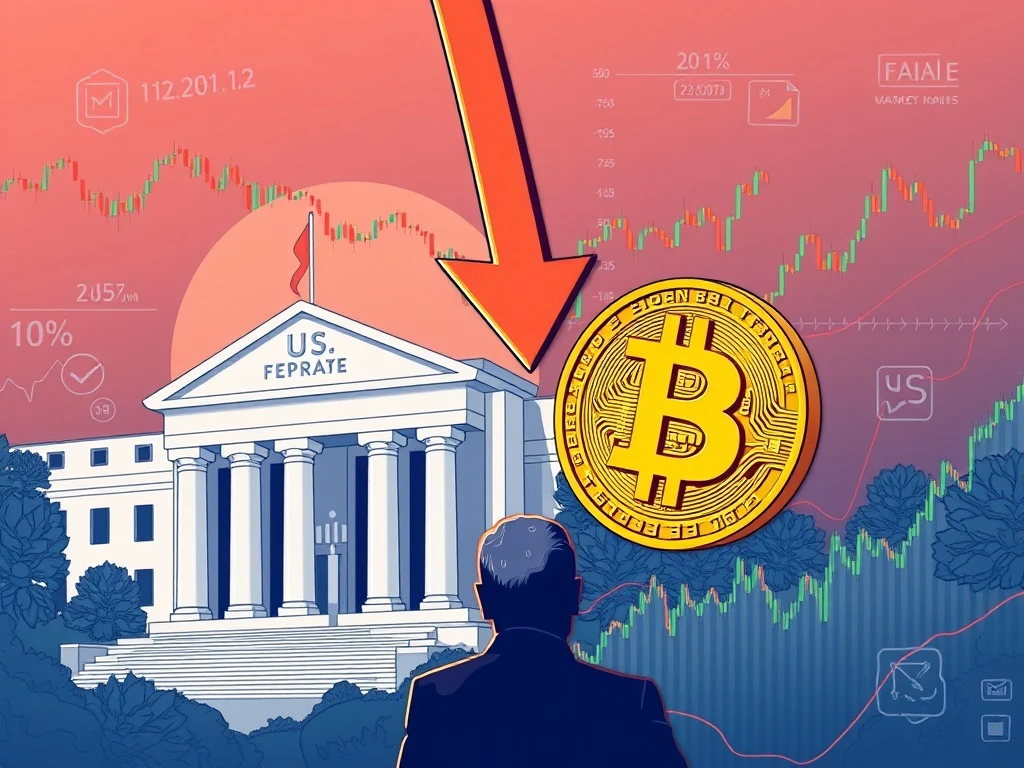Bitcoin ETFs Witness Dramatic $470M Outflows Amid Fed Rate Cuts and Trump’s Trade Talks

The cryptocurrency market recently experienced significant shifts. Bitcoin ETFs, crucial investment vehicles, recorded their largest daily outflows in two weeks. This movement occurred amidst a period of notable macroeconomic and political developments. Investors are closely watching how these events impact the broader digital asset landscape.
Bitcoin ETFs Face Substantial Outflows
US-listed spot Bitcoin ETFs collectively shed a staggering $470 million on Wednesday. This substantial figure marks the largest single day of BTC outflows in two weeks. Data from Farside Investors clearly illustrates this significant market reaction. Consequently, the price of Bitcoin briefly dipped below $108,000 before showing signs of recovery.
Several prominent funds contributed to this exodus:
- Fidelity’s FBTC led with $164 million in outflows.
- ARK Invest’s ARKB followed, experiencing a pullback of $143 million.
- BlackRock’s IBIT registered $88 million in outflows.
- Grayscale’s GBTC also recorded $65 million leaving its coffers.
- Bitwise’s Bitcoin ETF BITB saw a relatively minor loss of $6 million.
This recent downturn contrasts sharply with previous days. Earlier in the week, these same ETFs enjoyed steady gains. Monday saw $149 million in inflows, while Tuesday brought over $202 million. Therefore, Wednesday’s figures represent a sharp reversal in investor sentiment. The outflows have reduced cumulative net inflows to $61 billion. Furthermore, total assets under management have declined to $149 billion. This now represents 6.75% of Bitcoin’s (BTC) market capitalization, according to crypto investment research platform SoSoValue.
Fed Rate Cuts Influence Crypto Market Dynamics
A key factor influencing these market movements was the US Federal Reserve’s recent decision. The Fed opted to cut interest rates by 25 basis points. This move often impacts traditional financial markets significantly. Consequently, it led to a choppy trading day for US markets. The crypto market frequently reacts to such macroeconomic signals. Therefore, many investors observed increased volatility following the announcement.
Initially, this rate cut seemed to put downward pressure on the Bitcoin price. However, other global events also played a role. US President Donald Trump and Chinese President Xi Jinping held a meeting. They discussed ongoing trade tensions between their two countries. Subsequently, Bitcoin’s price appeared to gain some ground after these discussions. This suggests that a complex interplay of economic and political factors drives current market sentiment.
Understanding Bitcoin Price Fluctuations
The Bitcoin price has exhibited considerable movement over the past 24 hours. According to CoinGecko, it drifted between $108,201 and $113,567. This fluctuation highlights the asset’s inherent volatility. Despite the Federal Reserve’s decision to cut interest rates, Bitcoin initially fell. Analysts often link interest rate cuts to potential inflation, which could theoretically boost demand for scarce assets like Bitcoin. However, the immediate market reaction was negative. This demonstrates the unpredictable nature of the market.
Later, the meeting between President Trump and President Xi Jinping offered a potential turning point. Discussions around trade tensions can impact global economic stability. Positive dialogue can often ease market anxieties. Consequently, Bitcoin’s price showed signs of recovery after this political engagement. This underscores the importance of both monetary policy and geopolitical events on the broader crypto market.
Bitcoin ETFs Still Hold Significant Assets
Despite the recent BTC outflows, Bitcoin ETFs maintain substantial holdings. Analysts have previously noted a strong link between ETF flows and Bitcoin’s price. For example, a rally in early October stemmed from large inflows into these investment vehicles. Furthermore, these funds collectively hold over 1.5 million Bitcoin. This impressive figure is worth approximately $169 billion. It represents 7.3% of Bitcoin’s total supply, as reported by Bitbo.
Individual ETF holdings remain robust:
- BlackRock’s IBIT leads the pack with 805,239 Bitcoin.
- Fidelity’s ETF holds the second-largest amount with 206,258 Bitcoin.
- Grayscale’s GBTC possesses the third-largest holdings, totaling 172,122 tokens.
These figures demonstrate the enduring institutional interest in Bitcoin. They also highlight the significant role ETFs play in its market distribution. Therefore, while short-term fluctuations occur, the underlying infrastructure of institutional adoption remains strong.
Optimistic Forecasts for the Crypto Market
Volatility is a constant feature of the crypto market. However, not everyone expresses concern over price movements. Michael Saylor, co-founder of MicroStrategy, remains notably bullish. He made a strong forecast on Monday. Saylor believes Bitcoin will still reach $150,000 by the end of 2025. He attributes this optimism to positive developments within the space. Such long-term predictions often provide a counter-narrative to short-term market anxieties.
Analysts often consider these dynamics healthy for the market. They suggest that rotations out of certain assets can lead to new opportunities. This ongoing evolution indicates a maturing market. Investors are continually assessing risks and rewards. Consequently, while current outflows grab headlines, many industry leaders maintain a positive long-term outlook for Bitcoin and the broader digital asset ecosystem.









